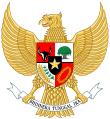
Abdurrahman Wahid, more colloquially known as Gus Dur, was an Indonesian politician and Islamic religious leader who served as the fourth president of Indonesia, from his election in 1999 until he was removed from office in 2001. A long time leader within the Nahdlatul Ulama organization, he was the founder of the National Awakening Party (PKB). He was the son of Minister of Religious Affairs Wahid Hasyim, and the grandson of Nahdatul Ulama founder Hasyim Asy'ari. Due to a visual impairment caused by glaucoma, he was blind in the left eye and partially blind in his right eye. He was the first president of Indonesia to have had physical disabilities. The name Abdurrahman Wahid means "Servant of Mercy the First."
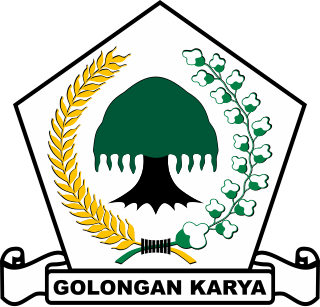
The Party of Functional Groups, often known by its abbreviation Golkar, is a centre-right big tent secular nationalist political party in Indonesia. Founded in 1964 as the Joint Secretariat of Functional Groups, it is the oldest extant political party in Indonesia. It first participated in national elections in 1971 as Functional Groups. Since 2009, it has been the second-largest party in the House of Representatives (DPR), having won 102 seats in the latest election.

The United Development Party is an Islam-based political party in Indonesia.

The National Awakening Party, frequently abbreviated to PKB, is an Islam-based political party in Indonesia. It is also the party of the former Vice President of Indonesia, Ma'ruf Amin, who was elected to its Shura Council.

Legislative elections were held in on 5 April 2004 for both houses of the People's Consultative Assembly of Indonesia. This included all 550 seats in the People's Representative Council and 128 seats of the newly formed Regional Representative Council.

Presidential elections were held in Indonesia on 5 July and 20 September 2004. As no candidate won a majority in the first round, a runoff was held, in which Susilo Bambang Yudhoyono defeated Megawati Sukarnoputri and was elected president. They were the first direct presidential elections in the history of Indonesia; prior to a 2002 amendment to the Constitution of Indonesia, both the president and vice president had been elected by the People's Consultative Assembly (MPR).

Elections in Indonesia have taken place since 1955 to elect a legislature. At a national level, Indonesian people did not elect a head of state – the president – until 2004. Since then, the president is elected for a five-year term, as are the 580-member People's Representative Council, the 152-seat Regional Representative Council in 2024 general election, in addition to provincial and municipal legislative councils.

The Indonesian Democratic Party was a political party in Indonesia which existed from 1973 to 2003. During the New Order era, the PDI was one of the two state-approved parties, the other being the Islam-based United Development Party (PPP).

Sudharmono, also known by his nickname, Pak Dar, was an Indonesian Army officer and politician, who served as the fifth vice president of Indonesia from 1988 until 1993 under the New Order regime. Previously, he served in several positions in the government and military, including as the Chairman of Golkar, State Secretary of Indonesia, and a lieutenant general in the army.
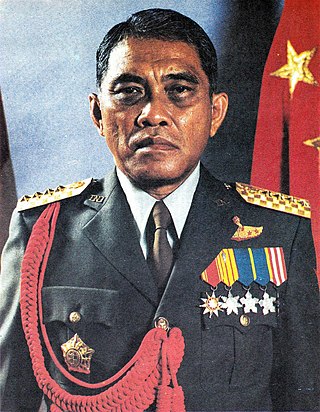
General (Ret.) Leonardus Benjamin Moerdani was the ABRI Commander from 1983 to 1988 and also served as Indonesia's Minister of Defense and Security. He is famously remembered due to his strong stance in many decisive situations in Indonesian political and social life. He was also significant as a leader who was Catholic in a predominantly Muslim community.
Legislative elections were held in Indonesia on 29 May 1997. There were three simultaneous elections in one because voters were electing members of two levels of regional government as well as the national-level People's Representative Council. This was the last election of President Suharto's New Order regime, which collapsed one year later. Like the preceding New Order elections, it was won outright by the Golkar organization.

Legislative elections were held in Indonesia on 3 July 1971, the first under the New Order regime. There were ten participants; nine political parties and the "functional group" Golkar, which came first with more than 60 percent of the vote, resulting in an absolute majority in the People's Representative Council.

Legislative elections were held in Indonesia on 2 May 1977. They were the third legislative elections since independence, and the second under the New Order regime. There were three participants; the two political parties and functional group Golkar.

Legislative elections were held in Indonesia on 4 May 1982. They were the fourth legislative elections since independence and the third under the New Order regime There were three participants; the two political parties, the United Development Party (PPP), the Indonesian Democratic Party (PDI) and the "functional group" Golkar. As with all elections during the New Order regime, the government-backed Golkar organization won an absolute majority.
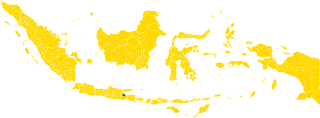
Legislative elections were held in Indonesia on 9 June 1992, to select 400 of the 500 members of the People's Representative Council (DPR). The election was the sixth legislative elections since Indonesian independence and the fifth legislative elections under the New Order regime of president Suharto. The election resulted in a clear victory for Golkar, which retained its status as the ruling party, although the opposition, under the United Development Party (PPP) and the Indonesian Democratic Party (PDI), saw their vote shares rise.

Early legislative elections were held in Indonesia on 7 June 1999. They were the first elections since the fall of Suharto and end of the New Order, the first free elections in Indonesia since 1955, and the first and only free legislative election held in East Timor during Indonesian provincehood. With the ending of restrictions on political activity following the fall of Suharto, a total of 48 parties contested the 462 seats up for election in the People's Representative Council. A further 38 seats were reserved for members of the armed forces.
The 27 July Incident was an attack by Indonesian government forces on the head office of the Indonesian Democratic Party, which was being occupied by supporters of recently ousted party leader Megawati Sukarnoputri. It was followed by two days of riots in Jakarta.
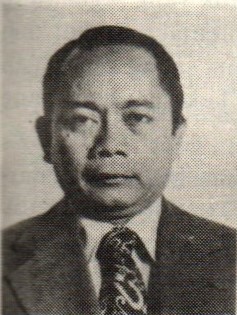
Jailani "John" Naro, also known as Haji Naro or John Naro was a former prosecutor that became an Indonesian politician.
The General Elections Institution was the body that organises elections in Indonesia during the New Order. Its responsibilities include deciding which parties can contest elections, organising the voting and announcing the results and seats won in the various branches of the government. The institution is under the Ministry of Home Affairs.

The Indonesian Democratic Union Party,, was a political party founded by Sri Bintang Pamungkas in 1995 and one of the political parties in Indonesia that participated in the 1999 general elections.
